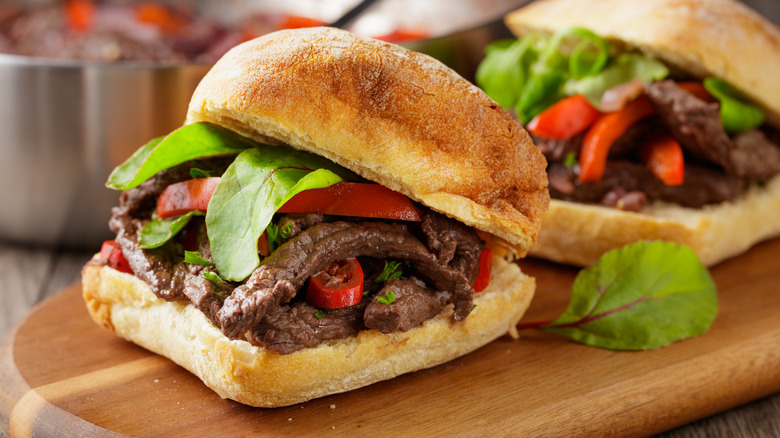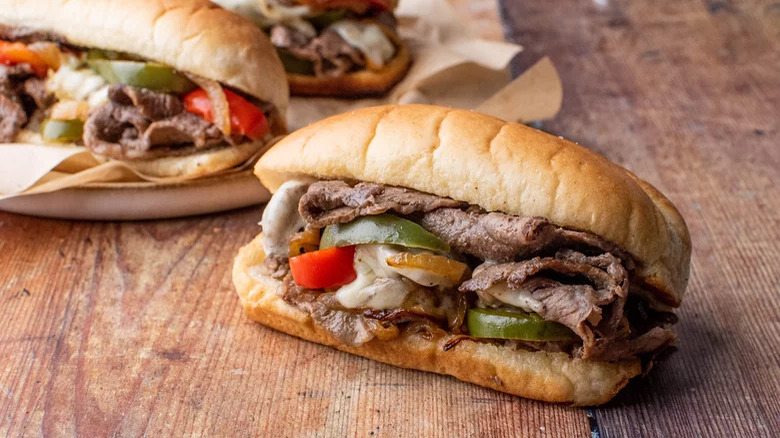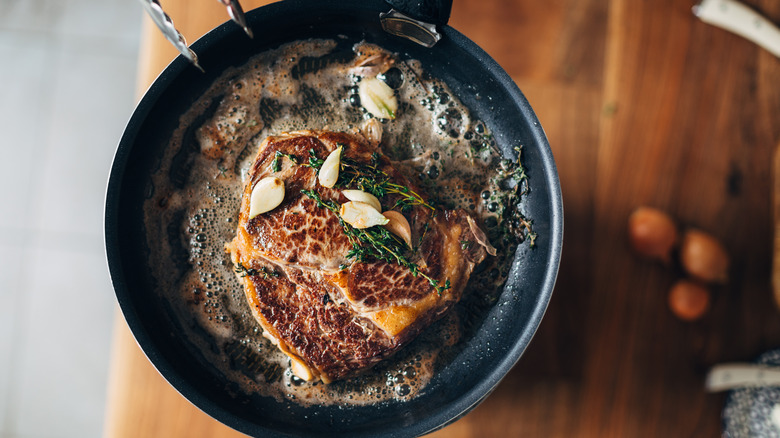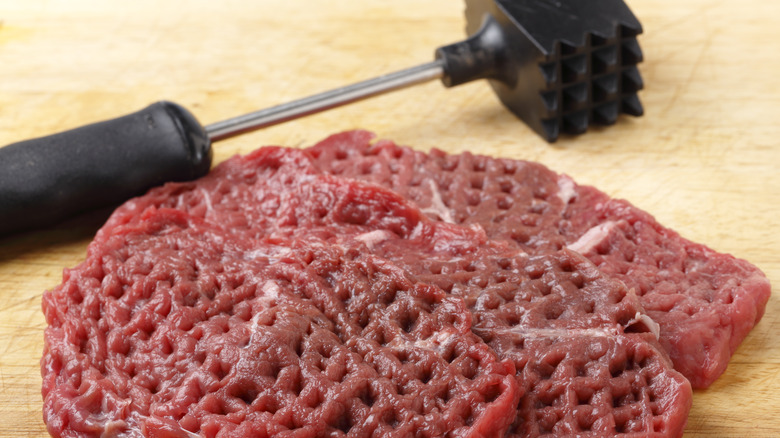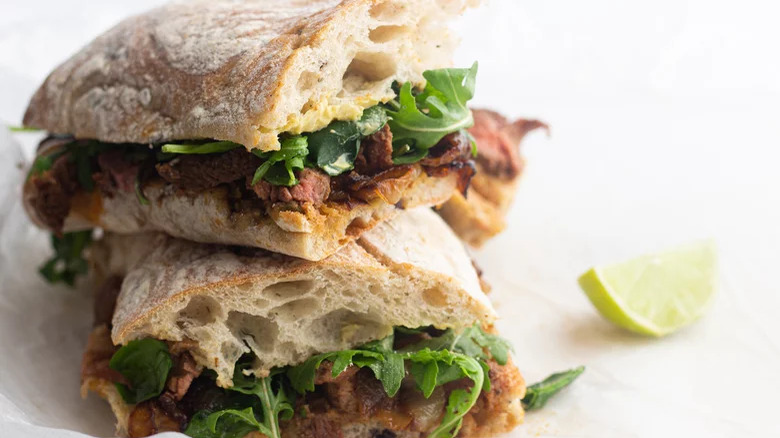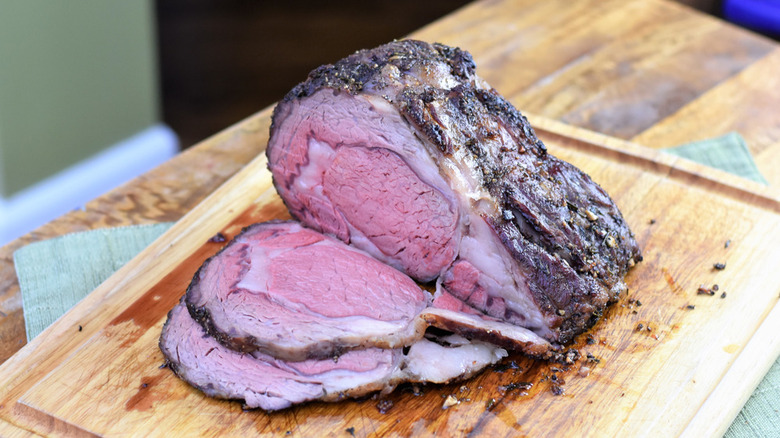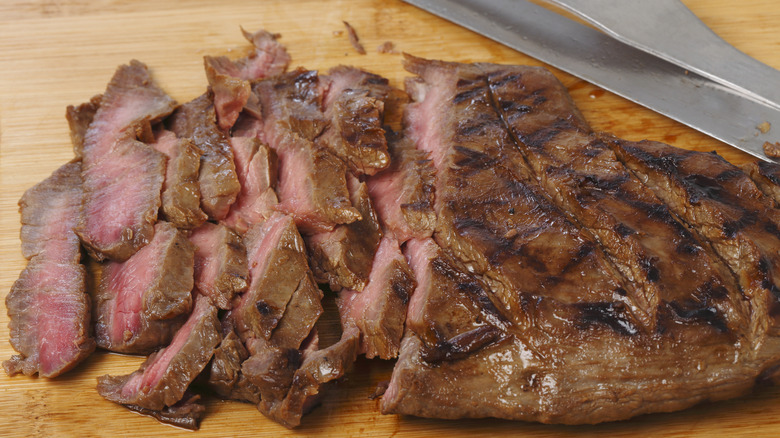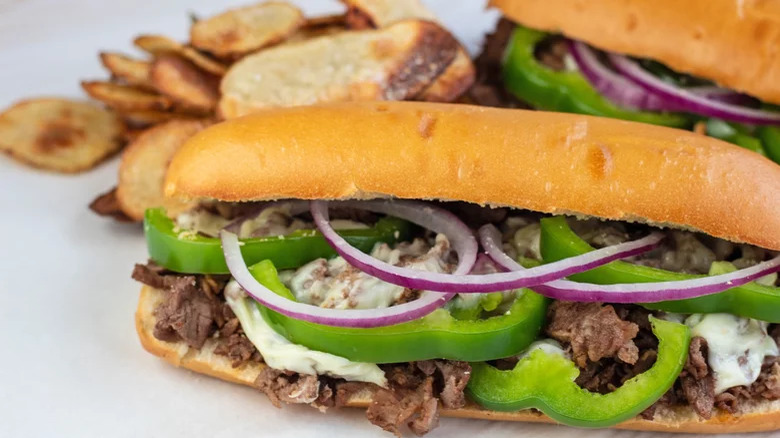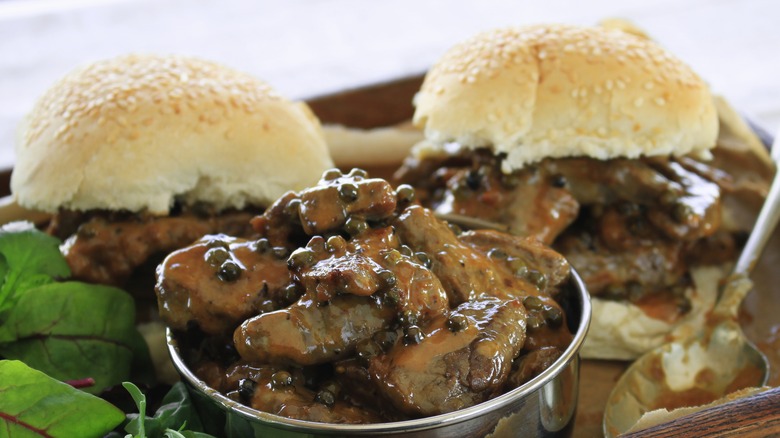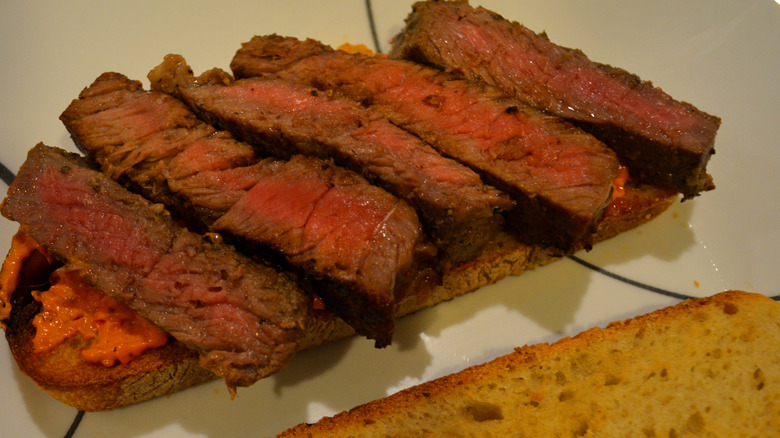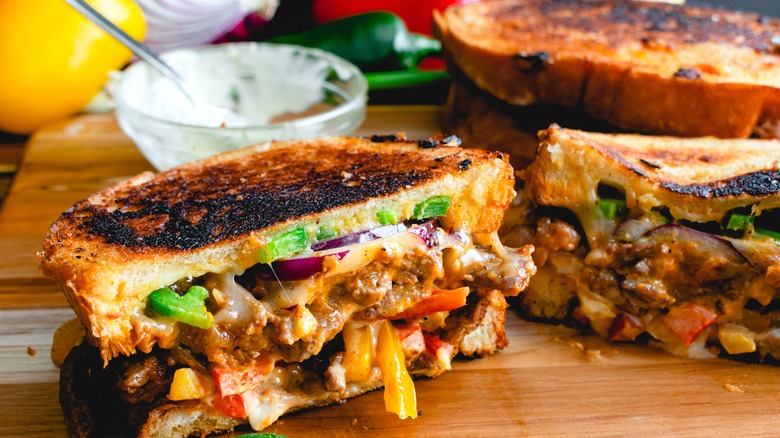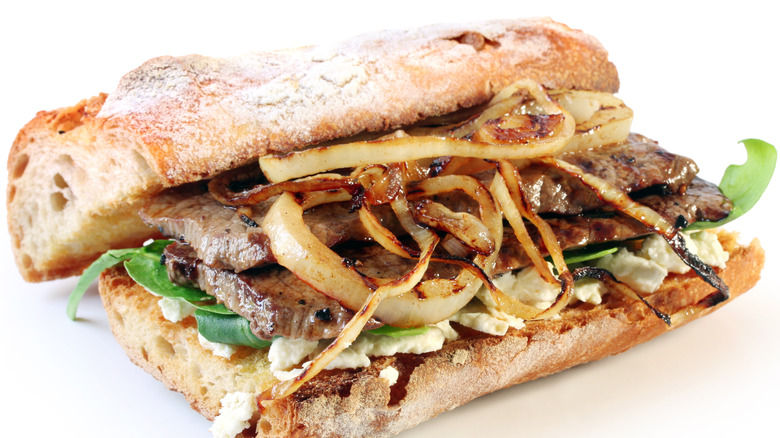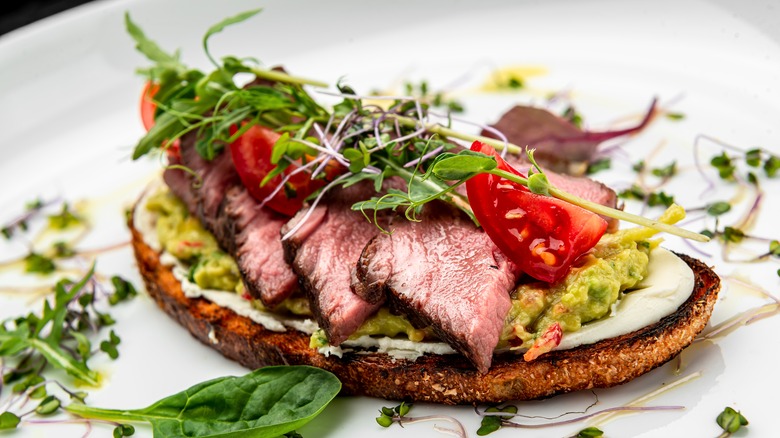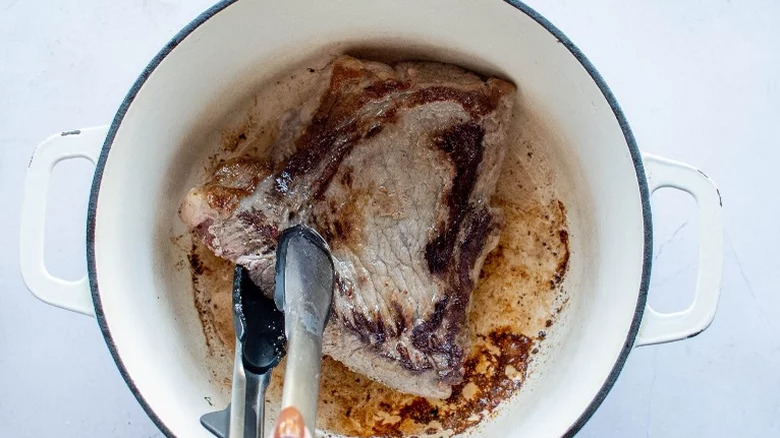Big Mistakes Everyone Makes When Cooking Steak Sandwiches
Chowing down on a steak sandwich can either be sublime or underwhelming. If you're grabbing a hot sandwich out and about, then plenty of chain restaurants offer steak sandwiches for you to get your fix, but they're also relatively simple to rustle up at home. Even though it is a seemingly straightforward meal that's easy to learn how to do, it can be slightly trickier to master. In other words, there's a lot that can elevate the flavor, but if you miss a beat then you might end up with a subpar sandwich.
Steak sandwiches need to be moreish and richly flavored, with a great-tasting, juicy cut of beef that's perfectly tender. You want the bread, toppings, and condiments to work together taste-wise, too — complementing rather than overwhelming the meat. Here are some big mistakes everyone makes when cooking steak sandwiches, and how you can avoid them.
Not using shaved steak for a Philly cheesesteak
One of the best hot sandwiches you can make at home is an easy Philly cheesesteak. The combination of hot golden-crusted hoagie rolls with glistening fried peppers and onions is scrumptious with shavings of seared beef and molten slices of provolone cheese. The key mistake to avoid here is using beef that is too thick. New York strip and ribeye are excellent choices for this sandwich, as is sirloin, and you can even use chuck steak if it's thin enough. What you don't want — even with the tenderest of cuts — is to add a big slab of meat into this sandwich. You want the thinly sliced seasoned beef to pick up flavors of garlic powder and Worcestershire sauce while in the skillet.
The point of using shaved beef is that you can get the right balance of tenderness and crispiness. You want the slices to be a little frizzled without burning to a crisp. A great tip for slicing beef thinly — if you don't get pre-sliced meat from the store or have a butcher slice it for you — is to first leave it in the freezer. Leave the joint of meat for a couple of hours so that it's not as soft, making it easier to cut with a good, sharp knife.
Not choosing the right steaks for thick cuts
Strips of beef cut from a cooked steak are undoubtedly easier to eat in a sandwich than big chunks of meat — but that's not to say you can't have thicker cuts, as long as you make sure you use the right steak. If you love super-lean cuts such as filet mignon and tenderloin, then go ahead and enjoy a gourmet sandwich. If you want a steak with enough fat in it to boost the juiciness, then ribeye, prime rib, and sirloin steaks are great, along with hangar steak and New York strip. When choosing a cut of meat such as a ribeye, look for good marbling in the beef as this fat will add to the flavor, and fry with the thick cap of fat on, too.
Skirt and flank steak are both lean but tough. Beef chuck roast is usually used for stews and pot roasts. What you can do with these cuts is marinade them to tenderize the meat before frying, and you might want to add a little baking soda to the marinade to soften the beef. This process is called velveting.
Not flattening steak beforehand
A kitchen mallet is an invaluable tool for bashing down on a piece of beef, and other meats as well. However, you can always use a rolling pin if you don't have one. Either way, flattening meat in this way tenderizes it, and missing this step is a mistake if you want to make an amazing steak sandwich. If you're wondering how thin to go, then a good ballpark thickness is less than a ½ inch. If it's too thick, it's not going to taste balanced with the rest of the ingredients and be supported by the bread. You don't want to be trying to chew through a big steak to bite a piece of meat off. Tenderizing softens the texture and also makes the steak way more sandwich-friendly. You might flatten out the steak and then slice it after cooking as well.
Marinade acts as a tenderizer for beef, too. However, with different toppings to add, and possibly time constraints if you want a quick chow-down, this might not be the best choice. Hitting steak with a tenderizer is a quick and easy solution. Be sure to use the side of the hammer that isn't smooth so that the points can dig into the meat and break down the elements that make it tough.
Using the wrong type of bread
One of the biggest mistakes people make when cooking steak sandwiches has nothing to do with the meat, but the bread. The wrong type can ruin any sandwich, and with a hot meat filling that's juicy, there's more to think about than if you're making a simple cheese sandwich for sure. Ciabatta is a robust, light, and chewy bread that is perfect for soaking up juicy fried steak. It's not going to fall apart with Dijon mustard and toppings added to the slices of meat, either. Kaiser rolls are a good alternative, too.
To heat the ciabatta, brush the halves with oil and toast under the broiler. You want softness and some crispiness so toasting bread is best for a steak sandwich. Avoid flimsy sliced bread and rolls that are ultra-squishy as the juices will leak through and cause your sandwich to fall apart. Sourdough may seem a good choice in theory, but you might find it a little too filling with the meat and other ingredients as well.
Always frying the steak
You've got your steak tenderized, your ciabatta toasting, and your skillet heating. The toppings are prepped and you're good to go. There's no doubt that a fried steak is not only delicious, but frying on your stovetop gives you a visual of how the meat is cooking. Getting the right sear on the outside and pinkness in the middle is not always easy to master without experience. However, while caramelizing meat in this way is mouthwatering, it can be a mistake to think that this is the only way to cook meat for a steak sandwich.
Roasting beef also opens up other cuts that you can use to make a tender-tasting sandwich such as chuck roast, top sirloin, and round steak. This is because you can roast the meat low and slow, which makes it super-tender. One advantage that can't be ignored here is that you can make steak sandwiches for a social gathering without spending a fortune on the best cuts. Other ways to cook up a succulent steak include sous vide, grilling, broiling, and smoking. Whether you marinade the meat or add a dry rub or a seasoned crust, venture beyond simple frying to step your steak sandwich up a notch.
Not slicing against the grain
Your steak is beautifully cooked and because it's fairly thick, you're going to need to slice it to make your sandwich easier to eat. You'll need a sharp knife, otherwise you'll end up hacking into the meat and creating uneven chunks. Have you let the meat rest a while? It's always important to let steaks rest, so no matter how hungry you are, don't cut into it as soon as it's out of the skillet. An important rule you'll want to follow for the tastiest texture is to slice against the grain. Look for the direction the grain is running, as it changes depending on the cut, and slice at a right angle to that rather than along it. This is the difference between a chewy strip that you have to gnaw on, or a tender piece of steak that breaks gently.
The texture will also be affected by how thick the slices are. If the meat is too strong, it's going to be a challenge to eat it in a sandwich.
Forgetting the importance of toppings
Indeed, a garnish can sometimes be something of an afterthought. After all, it's often about adding a pop of color or a suggestion of culinary influence rather than being integral to a dish. That's probably why vibrant parsley is so ubiquitous in sandwiches. However, treating toppings in the same laissez-faire way is one of the big mistakes everyone makes when cooking steak sandwiches. Don't be fooled: Toppings can make or break a steak sandwich.
Cheese is a classic topping, as are caramelized onions, and a selection of condiments. One sandwich shop that specializes in hot subs with a wide range of toppings is Subway. Draw inspiration from the chain and customize a hot sandwich with green bell pepper, red onion, and slices of American cheese. To elevate your sandwich further, what about adding Swiss cheese, blue cheese, or adding a fried egg? You could try sautéed shitake mushrooms or sweet shallots in place of onions. You could add onion rings and arugula for a little greenery, or what about spicy peppers or a fruity relish? Experiment with your favorite toppings and try and choose ones that complement the steak.
Thinking you cannot add a sauce
Don't make the mistake of thinking that sauces are a no-go for a steak sandwich. If a rich sauce is great with a steak on a plate, then guess what, it's going to pair just as well when the meat is in a ciabatta. Serve sliced roast sirloin tip in a French roll with slow-roasted onions and Swiss cheese. Broil so the cheese melts and serve with juices from the pot roast with beef broth, Worcestershire sauce, and garlic on the side for dipping.
Some sauces you might consider on your sandwich or using as a dip are brandy-peppercorn steak sauce; French dip; Bearnaise sauce, which is buttery with an intense tarragon taste; or blue sauce is also a popular choice. Just keep in mind that a delicate textured and supremely tender steak may suit a sublime cream-based sauce with a velvety consistency. If your steak sandwich is a little more rustic than refined, why not create your own sauce using sour cream or mayo as a base?
Not adding a condiment with a kick
Since it goes so well with beefburgers, simply add mustard from a jar to your steak sandwich. There are plenty of varieties, from powerful English mustard that clears the airways to a more mellow French. Turn stone-ground mustard into a creamy, spicy condiment by mixing it with mayonnaise, minced garlic, and Worcestershire sauce.
This boosts the flavor profile and gives the beefy flavor added depth. Unless you shy away from anything spicy, you'll want to make sure your choice of condiment has got a bit of a kick to it. Combine a chipotle in adobo and the sauce with mayo, lime juice, and salt and you've got a classic chipotle mayo. Another option: why not add hot sauce, Sriracha, or Dijon mustard and cayenne pepper to make it a spicy, garlic aioli-inspired sandwich? Other things you should consider include creamy horseradish sauce, which packs quite a punch, or simply mixing mayo and mustard for an instant hit.
Not getting creative with the flavors
Toppings, sauces, condiments, and marinades all add flavor to a steak sandwich. There's nothing wrong with playing it safe with a pared-back flavor profile, especially if you're frying up a sensational slab of steak, but it could mean that you're missing out on what might become your signature steak sandwich.
Not letting your creative culinary juices flow can be a mistake. Nothing is stopping you from bringing in Asian ingredients, for example. Embrace a Korean-style taste by marinating the steak in soy sauce, gochujang, apple, and garlic, with sesame oil, ginger, and rice wine. If you don't have all these ingredients, then keep it simple with soy sauce and Worcestershire sauce mixed with balsamic vinegar, lime juice, and garlic. For a Thai-inspired steak sandwich, mix soy sauce, honey, and chili marinade with ginger, then offset the spice with mango and Thai basil.
Imagine a steak sandwich with a double whammy of spicy condiments using a combo of chipotle mayo and homemade chimichurri sauce with cumin and crushed red peppers. You might want to serve this with baked Cajun sweet potato fries or complement mustard under the steak with a topping of pickled jalapeños to finish.
Getting caramelized onions wrong
Just to be clear, there's no reason why you can't double down on the onions with a steak sandwich, adding both crispy and caramelized ones. However, making a mess of the latter is one of the big mistakes everyone makes when cooking steak sandwiches. Get them right and they are phenomenal. Get them wrong and they might still be tasty, but they aren't going to be bursting with umami sweet and savory notes.
Add flavor to onions while you cook them by sautéeing them slowly in beef tallow. Salt, Worcestershire sauce, and balsamic glaze also create a wonderful depth of sweetness and saltiness with a gorgeous tangy taste. If you're standing over a stovetop then to bring out the soft texture and rich flavor you might need around an hour. Another option is to make them overnight in a slow cooker; after ten hours, the natural sugars come out. You can keep the softened veg in the fridge for a few days or in the freezer for longer.
Not going gourmet with the ingredients
If you choose the best, tenderest cuts of steak, then a down-to-earth steak sarnie can turn into a high-end bite to eat. Before you tut-tut at the idea of a tenderloin steak sandwich, consider how using gourmet ingredients can elevate it. Use crusty bread and add extras that are restaurant-style.
Make an open sandwich with thick slices of steak on top of cream cheese and guac with microgreen garnish. Or, start with a good cut of beef such as ribeye. Add provolone and fontina cheese slices on top of sliced ribeye steak, too, and broil. Top with arugula, mayo, and mustard, and serve with a homemade just to really impress your guests. What about lashings of thick cream cheese with garlic and herbs underneath slices of tender meat with peppery watercress on top? Versions of this idea have appeared on TikTok with a Boursin cheese steak sandwich with roasted garlic and shallot butter.
Not considering larger cuts of beef
If you're limited by time or you want a quick steak sandwich then you don't want to be toiling away in the kitchen for hours with a myriad of ingredients. However, if you want to savor an authentic Chicago-style beef sandwich, and can start prepping a couple of days ahead, then go for it. For this recipe, you'll use top round roast or rump roast. Larger cuts are perfect for braising and you can still slice them thinly for a sandwich.
Once you've seared your joint of beef on all sides take it out of the Dutch Oven. Fry celery, onion, and garlic to soften, and add beef broth with herbs. Put the meat back into the pot and braise in the oven for an hour at 250 degrees Fahrenheit until the meat reaches 130 degrees Fahrenheit before taking it out. Add wafer-thin slices no more than an ⅛ inch thick to French rolls, and top with roasted green bell pepper for a little sweetness. Lastly, add a spoonful of homemade giardiniera made with cauliflower, fennel, carrot, and celery, plus jalapeño or serrano peppers. Waiting for the pickled veggies to be ready is what takes time, but it's worth it. Remember, big beef cuts that aren't cooked fast and are sliced thin can make more affordable and just as tasty steak sandwiches.
